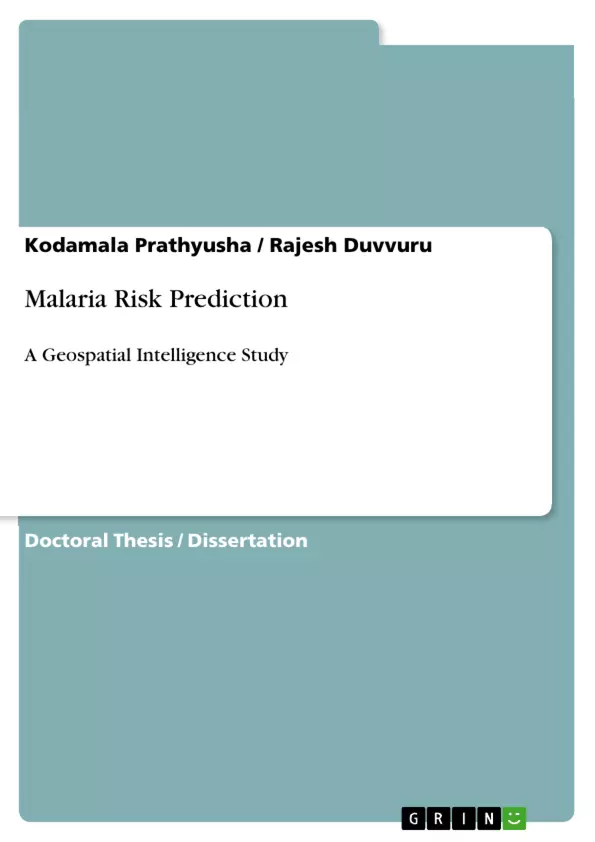The present study concentrated on the prediction of Malaria risk zones in the study area. According to WHO 2022 report, the disease claimed the lives of almost 274,000 kids under the age of five, or 67% of all malaria deaths worldwide. Major causes of death among children vary by age. It reflects that “Every two minutes, a child dies from malaria”. Also, it emphasizes third Sustainable Development Goal (SDG-3), which Ensure healthy lives and promote well-being for all at all ages, the world is not on a trajectory to achieve the SDG 3 target of ending malaria by 2030. Beside many Malaria reduction programs initiated by the local government and WHO, that reduced the impact of Malaria in many parts of the world. But the UN and WHO objective the Malaria should be endemic by 2030. In addition, The Institute of Health Metrics and Evaluation (IHME) world malaria statistics also shows that the malaria fatality is reduced from 8,92,032 to 6,26,909 during the years 2001-2020. The study area comprises of 12 Tribal population impacted mandals that covers 6,519.9 Sq. Km and chosen study area is prone to malaria disease. In order to reduce the Malaria hazard impact in the study area a right, the hotspot prediction method is needed which is of high importance. The present research proposed and developed a novel Spatial Analysis for Malaria Risk Reduction (SAMRR). The prediction accuracy of the SAMRR is very high compared with other Machine Learning (ML) algorithms. This work focuses on six objects related to ‘Malaria Health Hazard Risk Reduction’ with GIS and Machine Learning (ML) procedures. Data collected from various national and international research and academic repositories such as APSAC, APSDPS and DMFW dept. related to demographic, health and environmental aspects that are help to evaluate the malaria incidence in the study area.
Inhaltsverzeichnis (Table of Contents)
- Preface
- Acknowledgments
- Prologue/Introduction
- INTRODUCTION
- REVIEW OF LITERATURE
- MATERIALS AND METHODS
- RESULTS
- DISCUSSION
- SUMMARY AND CONCLUSIONS
- PLATES
- REFERENCES
Zielsetzung und Themenschwerpunkte (Objectives and Key Themes)
This book presents a geospatial intelligence study on malaria risk prediction. The primary objective is to leverage geographic information systems (GIS) and other spatial analysis techniques to develop a comprehensive understanding of malaria risk factors and their spatial distribution. This knowledge can then be used to develop targeted interventions and improve malaria control strategies. Key themes explored in the book include:- The role of environmental factors in malaria transmission
- The development and application of geospatial intelligence for malaria risk prediction
- The identification of areas with high malaria risk and the development of targeted interventions
- The potential for using GIS to inform public health policies and programs aimed at malaria control
Zusammenfassung der Kapitel (Chapter Summaries)
- Introduction: This chapter provides a comprehensive overview of malaria, its global burden, and the importance of understanding the disease's spatial distribution. It also introduces the concept of geospatial intelligence and its application to malaria risk prediction.
- Review of Literature: This chapter presents a critical review of existing literature on malaria, its transmission dynamics, and the use of geospatial methods for malaria risk prediction. It highlights the key findings and research gaps in the field.
- Materials and Methods: This chapter details the methodology employed in the study, including the data sources, spatial analysis techniques, and statistical methods used to develop the malaria risk prediction model.
- Results: This chapter presents the findings of the study, including the identification of areas with high malaria risk, the spatial distribution of risk factors, and the performance of the developed risk prediction model.
- Discussion: This chapter interprets the study's results, discussing the implications for malaria control strategies and the potential applications of the developed model in public health decision-making.
Schlüsselwörter (Keywords)
The book primarily focuses on geospatial intelligence, malaria, risk prediction, environmental factors, spatial analysis, GIS, public health, and disease control. It explores the development and application of geospatial methods for understanding and predicting malaria risk, ultimately aiming to contribute to improved control strategies and public health outcomes.- Quote paper
- Dr. Kodamala Prathyusha (Author), Dr. Rajesh Duvvuru (Author), 2024, Malaria Risk Prediction, Munich, GRIN Verlag, https://www.grin.com/document/1496925



